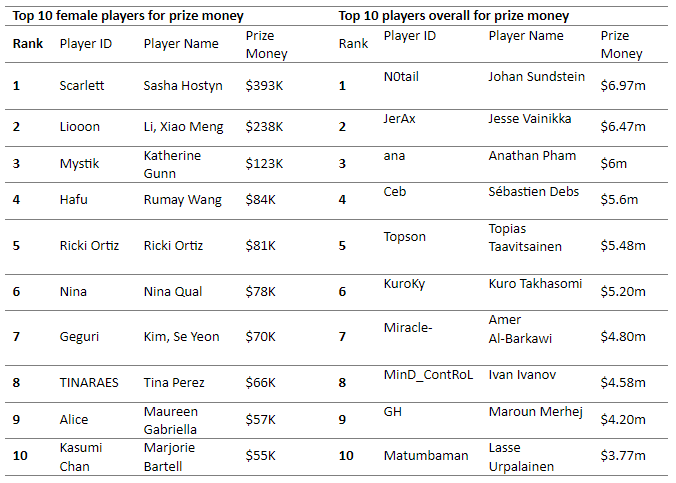According to a new analysis of player winnings, female esports stars are taking home 98% less than the average for top-100 players. Here, Peter Watton from matched betting specialists OddsMonkey takes a closer look at these findings, what they mean, and how they can be addressed.
If you take a moment to watch any top-level esports competition, chances are you’re going to see a line-up of competitors that are mostly male. It’s fair to say that the current elite esports landscape is dominated by men, and, for the majority of games, female gamers don’t feature at the very peak.
To get a real sense of just how few women are competing at the highest level of esports, you just need to take a look at how much they earn in prize money across the industry. At OddsMonkey, we did exactly this, and, while we anticipated an earnings gap, we were surprised at the size of it.
Female esports earnings compared to the average
We calculated the average career earnings totals for players ranked in the top 100 for prize money, which is $1,991,618.32, and then compared it to the average for the top 100 female esports earners at just $33,202.21 — that’s 98% less. In simpler terms: for every £100 earned by the average elite esports gamer, a female gamer is taking home just £1.67.
To get these insights, we used prize money data from Esportsearnings.com, calculating our averages from their top 100 highest-earning players and their top 100 highest-earning female esports players. Taking just a cursory glance at the top 10 for each of these is enough to see there is a huge gap in winnings:

Taking a closer look at the very top of both tables, we can see that the top female player is Sasha Hostyn, who is best known by her player tag Scarlett, and the top overall player is Johan Sundstein (N0tail). Scarlett has earned $393,000 over the course of her whole career, which is just over 5% of the $6.97 million in winnings N0tail has accumulated. To see how the best female player fits into the top earners overall, you have to step back and look at the top 500, because she is only at 325.
Why is this the current status quo?
Our analysis demonstrates that there is widespread underrepresentation of women competing at the highest level of esports. The findings do not tally with the proportion of gamers who are female — this has been found to be as high as 46% in recent times (Statista) — which suggests that there should be greater representation at the elite level of the industry. Esports is open to people of all genders, so it seems like there is untapped potential that is not finding its way to the peak.
The earnings disparity is certainly not based on ability, as there is not a lack of skill among female gamers — as demonstrated by the few that have achieved success. Instead, I would look towards the culture that surrounds esports. It is a space that is very much male-dominated, and it also comes with a level of stigma and toxicity that can be incredibly off-putting for women who would like to participate. With a shift in this culture, we may see more female gamers feeling like they are able to comfortably compete and reach the top.
There are a few things that could be done to address this issue. For one, if more time was taken to celebrate female esports players as role models, it would put them in the spotlight as role models for the next generation of gamers. It could also be beneficial to establish all-female esports teams and clubs to boost participation by offering a safe space. Finally, steps need to be taken across the board to address the stigma of women in the gaming sector, as true change can’t occur until the industry is, on the whole, more accepting.
The fact that top female esports players earn so much less than the average elite gamer is quite shocking and a reminder that esports has a long way to go. However, by taking the right steps, hopefully, more women will feel comfortable competing and reaching the pinnacle of the sport.
For even more opinion pieces like this, please click HERE.